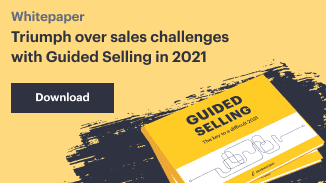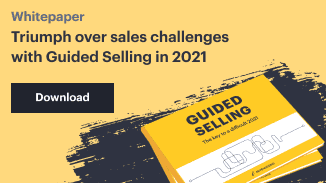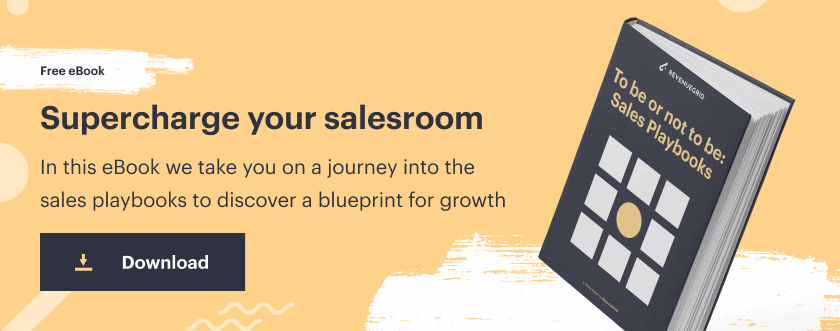Words have serious power.
They make us feel things, imagine possibilities, establish trust, and for better or worse, they shape our reality.
Word choice, of course, also has a profound impact on the pipeline, and the subtle difference between an “and” and a “but” could make a prospect reconsider your proposal.
So, what kind of words move the needle on sales?
Below, I’ll share 15 words that sell and why they have such a positive influence on the pipeline—when used correctly, of course.
Words that sell: 15 power words that move deals forward
1. You. Selling is all about the buyer, it’s not about your company, your quota, or your competitors. As such, you’ll want to build your sales pitch around the idea that your prospect is the protagonist of their own story.
2. The prospect’s name. The idea that the sweetest sound to a prospect’s ears is “the sound of their own name” is something of a cliche, but science backs it up. According to a study, hearing one’s own name activates multiple regions of the brain compared to hearing the names of others.
That said, don’t overuse the name drop approach. My recommendation is that you use the prospect’s name when you greet them, end a conversation, and maybe, once in the middle, if you’re trying to refocus their attention. Avoid too many sentences that start like this: “now, Grace, how do you feel about X?”
At a certain point, this approach begins to border on psychopathic, becoming obvious to the buyer that the sales rep is trying to manipulate them.
The takeaway here is, you want the buyer to feel “seen,” like you understand their problems and have a plan for helping them reach their goals. Remember, “you” makes prospects feel special, too.
3. Value. Customers care more about the value your solution brings to their business than what kind of discount you can offer. Here, you’ll want to reiterate your unique value proposition and frame it as your prospect’s “competitive advantage.” The focus should always be on how the buyer can get more by adopting your solution, not how they can pay less.
4. Easy. Buyers hate friction. According to 2019 Futurum report that looked at the B2B Digital Buyers’ Journey, there are seven main pain points that buyers experience during the sales process: poor purchasing UX, implementation friction, disorganization, uncertainty, inflexibility, vendor lag, and renewal friction.
Bottom line, when something is easy, people are more open to the idea of using it.
A quick note: don’t forget the synonyms, words like “simple” or “seamless” work here, too.
5. Imagine. Instead of explaining your product/service in terms of what it can do, remember that people buy better versions of themselves. Getting buyers to imagine how a product or service can help them become more productive, appear smarter, or look more attractive gets them thinking about benefits, not features.
The word “imagine” leverages the power of something called “mirror neurons“, a term used to describe how feelings can be transferred to a person without experiencing them firsthand.
Use this word to tap into buyer emotions by painting a picture of how your solution will improve their life or solve a problem.
6. We. By now, you’ve probably seen countless articles that bring up the idea of a consultative sales process—positioning yourself as a trusted advisor. An important aspect of being able to do this is getting the customer to believe that you’re on their team.
Using the word “we” helps frame the sales process as a joint project and gives buyers the sense that this is a mutually-beneficial relationship. In fact, Gong.io research found swapping “I” for “we” increased success rates by 34%.
Beyond nurturing that collaborative spirit with individual buyers, using “we” (and “our,” “us” or “together”) is an effective tactic for building consensus among multiple stakeholders.
7. And. The word “and” is a critical word for keeping conversations moving forward.
“And” also comes with the added benefit of helping you avoid dropping “but” into the conversation, which has negative connotations.
8. Or. “Or” is a sort of cousin of “and” and is an effective word for presenting multiple options. After all, if you only propose one solution, you only give your prospect the option to say “yes” or “no.” On the contrary, if you present two or three different options, you’ve increased the chances of getting a “yes.”
When it’s time for negotiations, instead of asking the buyer to sign a contract, ask if they prefer version X or Y.
9. Avoid. As a salesperson, your goal is to help your prospect achieve their goals while also helping them avoid potential losses or more pain. Using the word “avoid” allows you to tap into the powerful concept of “loss aversion” which encourages people to act in ways that allow us to hang on to what we have.
According to Psychology Today, loss aversion is linked to the emotional pain of scaling back and is often the culprit behind our inherent resistance to change.
10. Proven. In today’s competitive sales landscape, sellers need to build trust right out of the gate. When you say ‘proven’, to your prospects, it reminds them that your solutions are market-tested and recommended.
A quick caveat, here. Don’t use “proven” unless, well, you can prove your claims. This means you’ll need to be prepared with relevant data from existing clients, testimonials, product demos, and even original research that reinforces the benefits of using your solution.
The idea is, once the prospect sees that you’ve got the data to back up your claims, they’ll be more comfortable sharing your proposal with the rest of the decision-making team.
In other words, “proof” goes a long way when it comes to nurturing “champions” on the inside.
11. First. Another universal truth about being human—we all want to be the “first” to try something new or solve a problem that has long plagued the industry. Look, there’s a reason the word “laggard” has a negative connotation.
The word “first” also suggests exclusivity and instantly captures buyers’ attention. By offering buyers a “first look” at the latest product/service you’re offering something that not everyone else can get AND you’re introducing the element of surprise.
12. Because. According to an oft-referenced 1977 Harvard experiment, the word “because” has a powerful effect on people as it provides justification for a behavior even if the logic doesn’t quite add up.
In the experiment, psychologist Ellen Langer and her team used three different excuses to try to cut the line for the Xerox machine.
That said, if you’re using this approach, it’s your responsibility to make sure that your offer delights, surprises, and solves problems, as promised.
- “I have five pages. May I use the xerox machine?”
- “May I use the xerox machine, because I have to make copies?”
- May I use the xerox machine, because I’m in a rush.
The first excuse doesn’t even attempt to offer a valid reason for cutting the Xerox line, the second offers an excuse that makes very little sense, and the third offers a clear explanation.
Still, 93% of people accepted the second excuse and 94% accepted the third. 60% agreed to the first.
For sellers, “because” holds power because it gives you an opportunity to present a compelling reason for prospects to take action—a simple move that can increase the chances of getting a “yes.”
13. Now. “Now” is a powerful word for creating a sense of urgency without turning up the pressure cooker.
To use “now” to drive action, you’ll want to show prospects the benefits they’ll receive by taking action ASAP. You might pair this one with “imagine” to amplify the effects.
It’s also worth noting that you’ll need to be SUPER clear about the immediate impact they’ll see right after making a deal.
14. Remember. “Remember” is another subtle word that can be highly effective in nudging deals forward by reminding prospects about looming deadlines or expiring offers without being overly aggressive.
Whether their free trial is about to expire or there’s a regulatory deadline just on the horizon, “remember” is ideal for reminding busy prospects that you have their best interests at heart.
15. I don’t know. Salespeople are expected to provide answers, but top-performers know that an “I don’t know” is sometimes the best way to build trust. Admitting that you don’t have an answer allows you to avoid inadvertently getting caught in a lie or misrepresenting their products/services. That said, it’s best to follow up “I don’t know,” with “but I can find out for you” whenever possible.
What words should you avoid?
1. Discount. According to a 2012 study, people love discounts. It’s just that the word “discount” is a real deal killer. Researchers found that people prefer to get 50% more of the same product for the same price than a blanket 33% discount, even though it’s the same thing.
As mentioned above, it’s all about framing, the 50% more option suggests “value,” while the 33% discount suggests “closeout.” The point is, “discount” sounds cheap, desperate, and conjures up an image of a carpet store going out of business—you know, “everything must go.”
2. “We provide…” In theory, there’s nothing that offensive about saying “we provide X, Y & Z,” however, it signals to prospects that they’re about to listen to a sales pitch, which immediately triggers the response to try to get out of the situation. Research has shown that “we provide….” can cause close rates to drop by a whopping 22%.
3. Contract. Contracts freak people out. They’re legally-binding and often hard to reverse once you’ve signed on the dotted line. Avoid scaring away prospects and use more neutral terms like “partnership” or “agreement” instead. Keep in mind, the payment sets off those internal alarm bells too.
4. Millions or billions. This is sort of a weird one, but the Gong report found that mentioning large, abstract quantities like million, billion, or trillion can hurt your close rate. This aversion could be linked to meganumerophobia, or the fear of very large numbers, where sufferers associate large, unimaginable quantities with losing their grip on reality. In any case, you’re better off focusing on tangible outcomes that support your pitch.
5. Your company’s name. Prospects might love the sound of their own name but they’re not exactly wild about your brand’s. When you’re trying to sell someone on a solution, it’s important to remember, they don’t care about you or your company, they care about solving their problem.
According to Gong.io, bringing up your company’s name more than four times in a call reduces close rates by 14%. Say it six times or more and sales rates drop by nearly 20%.
6. Free trial. Gong researchers also found that while people like the idea of free trials, the term “free trial” can have a slightly negative effect on moving the deal forward. Instead of using “free trial,” try “demo” or “pilot” to showcase your solutions.
Power words can’t stand alone
If you want to win deals, you’ll need to do more than plug the right words into your sales pitch and hope for the best.
Just to reiterate:
- Place the buyer at the center of the story, whether through personalizing the pitch or painting a picture of how things could be better for them if they adopt your solution.
- Always make sure you back up your claims with credible data or social proof.
- Introduce the possibility that things can be better—frame things in a positive light, using words like “opportunity” or “advantage” instead of “problem” or “challenge.”
- Steer clear of “deal killers” like “contract, “payment” or your company name.
Choose your words wisely and measure the results. Over time, you’ll see how your customers react to different words and can fine-tune your message accordingly.


